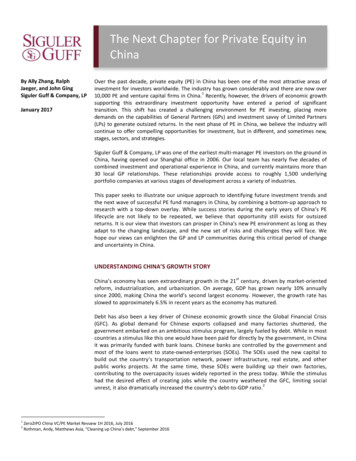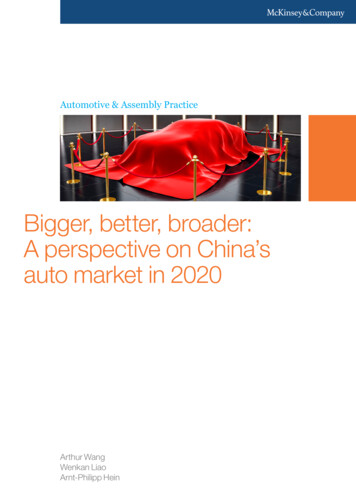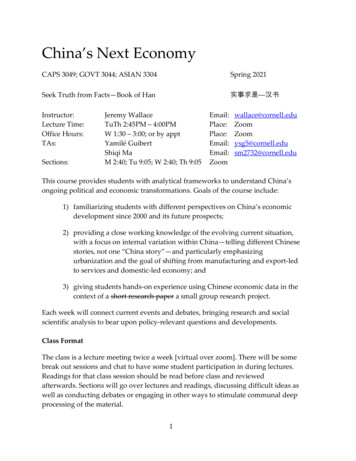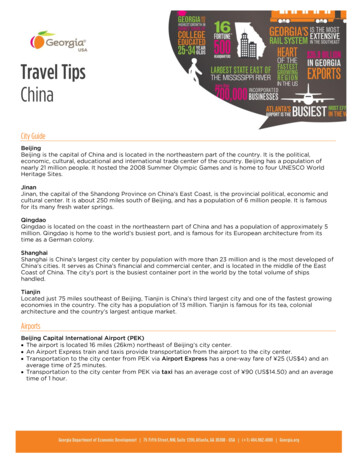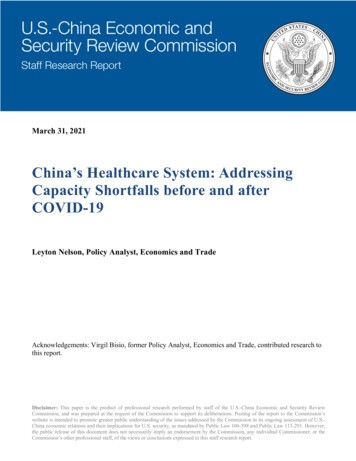
Transcription
March 31, 2021China’s Healthcare System: AddressingCapacity Shortfalls before and afterCOVID-19Leyton Nelson, Policy Analyst, Economics and TradeAcknowledgements: Virgil Bisio, former Policy Analyst, Economics and Trade, contributed research tothis report.Disclaimer: This paper is the product of professional research performed by staff of the U.S.-China Economic and Security ReviewCommission, and was prepared at the request of the Commission to support its deliberations. Posting of the report to the Commission’swebsite is intended to promote greater public understanding of the issues addressed by the Commission in its ongoing assessment of U.S.China economic relations and their implications for U.S. security, as mandated by Public Law 106-398 and Public Law 113-291. However,the public release of this document does not necessarily imply an endorsement by the Commission, any individual Commissioner, or theCommission’s other professional staff, of the views or conclusions expressed in this staff research report.
!Table of ContentsKey Findings . 1Introduction . 1Chronic Disease and Demographic Trends Strain China’s Healthcare System . 1As China’s Population Ages, Demand for Long-Term and Hospice Care Grows . 3Healthcare Capabilities Challenged by Funding Shortfalls . 4Public Health Insurance Coverage Uneven between Rural and Urban Residents . 5Funding Shortfalls Fuel Systemic Corruption . 6Beijing Seeks to Mitigate Healthcare Capacity Limitations . 7Conclusions and Considerations for Congress . 10Appendix: Healthy China 2030 Plan Major Targets . 12!"#" %&'()* ,-(-.',*)(/*#0,12'34*506'07*%-.'88'-(***
!Key Findings The novel coronavirus (COVID-19) pandemic has brought unprecedented attention to challenges in China’smedical system. While healthcare in China has made considerable strides in the past decade, it remains illequipped to deal with the country’s aging population and rising incidence of chronic disease. China’s healthcare system is overly reliant on urban hospitals to provide even basic healthcare services.Hospitals account for just 3.5 percent of medical institutions in China, but they handle 45 percent of alloutpatient visits. Per capita healthcare spending in China is increasing, but it remains low compared with other majoreconomies largely due to underfunding by the Chinese government. Budget shortfalls in China’s healthcareinstitutions are a major cause of widespread corruption in China’s medical system. Chinese policymakers have prioritized the improvement of healthcare outcomes, most notably in theHealthy China 2030 Plan released in 2016. In line with the goals articulated in this plan, the Chinesegovernment has sought to increase the capacity of its healthcare system through a variety of measures,including merging primary care facilities with hospitals and increasing the number of general practitionersin the country. As part of its broader efforts to gain soft power, the Chinese government has promoted traditional Chinesemedicine (TCM) both domestically and abroad, despite a lack of evidence showing the efficacy of manyTCM treatments. In the past several years, international organizations have begun incorporating TCM intomedical standards amid China’s push for greater recognition of TCM.IntroductionThe Chinese Communist Party (CCP) views the delivery of high-quality healthcare as an important aspect of itsown political legitimacy. While China’s government has made significant improvements to healthcare in the pastdecade, the healthcare system has not kept pace with many of the changing needs of China’s population. As lifeexpectancy has increased in China, so too has the burden of chronic diseases and the need for long-term and hospicecare—problems the healthcare system remains underequipped to address. These problems are compounded bypersistent budget shortfalls in many of China’s healthcare institutions that contribute to a widespread corruptionproblem. Aware of the potential for these challenges to undermine political stability in China, Chinese policymakershave prioritized reform of the healthcare system.This report reviews challenges in China’s domestic healthcare system and examines the efforts of China’spolicymakers to address these challenges. It also examines Chinese policymakers’ attempts to promote TCM bothdomestically and internationally. The report draws on the Commission’s May 2020 hearing on “China’s EvolvingHealthcare Ecosystem: Challenges and Opportunities” and open source research. It expands on topics explored inChapter 2, Section 3 of the Commission’s 2020 Annual Report, “U.S.-China Links in Healthcare andBiotechnology.”Chronic Disease and Demographic Trends Strain China’sHealthcare SystemOver the past decade, China has made significant progress in reducing the burden of diseases and risks related tomaternal, neonatal, and communicable conditions. For example, China’s infant mortality rate fell from 13.1 per*!"#" %&'()* ,-(-.',*)(/*#0,12'34*506'07*%-.'88'-(**9*
!thousand children born in 2010 to 5.6 per thousand in 2019. * 1 Over the same period, the maternal mortality ratefell from 30 deaths per 100 thousand to 17.8 deaths per 100 thousand. 2 Similarly, incidence of commoncommunicable diseases such as viral hepatitis, measles, and malaria have all decreased significantly.3 As peoplelive longer, however, the burden of chronic disease has risen, becoming a significant focus of Chinese healthcarepolicy. As of 2018, 270 million people in China were estimated to suffer from hypertension, and 116.4 million livedwith diabetes as of 2020.† 4 A variety of lifestyle and environmental factors, such as smoking and pollution, havealso contributed to the rising incidence and lethality of chronic disease. As of 2017, high blood pressure, smoking,high-sodium diets, and particulate matter pollution were the four greatest health risk factors and leading causes ofpremature death in China.‡ 5China’s healthcare system is underequipped to handle the growing burden of chronic disease. It is over-reliant onurban hospitals to provide basic care, and the primary care system, which should play a significant role in chronicdisease management, is underutilized. Beijing’s healthcare policies have long tried to foster preventative andprimary care as the most cost-effective way to provide healthcare services to China’s large population.6 However,primary care physicians, particularly those in rural areas, typically receive less training and are consequently lesstrusted by patients, who prefer to visit urban hospitals even for relatively minor conditions such as fevers andheadaches. Moreover, the expansion of healthcare coverage has enabled more patients to self-refer to facilities witha higher quality of care, leading to overcrowding at urban hospitals.7China’s Medical Education SystemChina’s medical education system is significantly less intensive than in the United States, where doctors must firstearn a bachelor’s degree, then attend medical school and complete a residency—a process taking ten or moreyears—before they are eligible to practice. Training pathways to becoming a practicing physician are also morediverse. Most doctors at China’s urban hospitals received at least four years of post-secondary medical education,but the average education level of rural doctors is considerably lower.8 As of 2014, only 11.9 percent of rural doctorshad received a bachelor’s degree. By contrast, 65.7 percent of doctors in urban hospitals had a bachelor’s degree.9To standardize medical education, in 2015 China’s National Health Commission launched a so-called “5 3” modelfor both general practitioner candidates and those pursuing a master’s degree in clinical medicine. In this revisedsystem, doctors must complete five years of post-secondary medical education followed by a three-year residency.10However, a range of other potential pathways continues to exist, particularly for general practitioner candidates.For example, high school students from poor rural backgrounds can take advantage of a tuition-free, five-yearmedical degree program, after which they receive a license to practice in designated rural areas only. They must*The lower infant mortality rates translate to a reduction from approximately 211,000 deaths in 2010 to approximately 82,000 deaths in2019. Total births in China totaled 16.15 million in 2009 and 14.65 million in 2019 as China’s birthrate fell to its lowest level since 1949.Amanda Lee, “China Population: Concerns Grow as Number of Registered Births in 2020 Plummet,” South China Morning Post, n-concerns-grow-numberregistered; BBC, “Chinese Birth Rate Falls to Lowest in Seven Decades,” January 17, 2020. †China now has the world’s largest population of diabetics, though in percentage terms the burden of the disease is still slightly less than inthe United States—10.9 percent of adults in China compared to 13.3 percent in the United States as of 2020. International DiabetesFederation, “IDF Western Pacific Members: China,” May 14, 2020. npacific/members/101-china.html; International Diabetes Federation, “IDF North American and Caribbean Members: United States,” March3, 2020. america-and-caribbean/members/74-usa.html; Hu Yiwei, “China’s DiabetesEpidemic in Charts,” China Global Television Network, November 14, 2019. cording to a 2018 survey conducted by the Chinese Center for Disease Control and Prevention, smoking rates among males remainstubbornly high. Although the overall smoking rate among adults was 26.6 percent, down slightly from 27.7 percent three years earlier,the smoking rate among male adults was 50.5 percent, down from 52.1 percent in 2015. See Chinese Center for Disease Control andPrevention, Results of the 2018 Survey of Chinese Adult Tobacco Usage—Smoking among Chinese Ages 15 Is Decreasing (2018 年中国成 人 烟 草 调 查 结 果 发 布 — 我 国 15 岁 及 以 上 人 群 吸 烟 率 呈 下 降 趋 势 ), May 30, 2019. Translation.http://www.chinacdc.cn/yw 9324/201905/t20190530 202932.html. Xinhua, “2015 China Adult Tobacco Survey Report: Chinese SmokersSmoke an Average of 15.2 Cigarettes per Day, and Second-Hand Smoke Exposure Has Improved” (2015 中国成人烟草调查报告:我国吸 烟 者 每 天 平 均 吸 烟 15.2 支二 手 烟 暴 露 有 所 改 善 ), December 28, 2015. search?q tent 5028569.htm &cd 3&hl en&ct clnk&gl us.*!"#" %&'()* ,-(-.',*)(/*#0,12'34*506'07*%-.'88'-(*:*
!then serve six years at a rural health organization before being permitted to practice at an urban hospital.11 Thereare also several ways for rural medical students to first become assistant general practitioners, with the possibilityof becoming fully licensed general practitioners with additional job transfer training.12Despite government efforts, China continues to experience an acute shortage of qualified doctors. The number ofdoctors has increased in recent years but still lags behind the growing volume of patient visits. Between 2009 and2019, the number of practicing doctors increased 68.6 percent from 1.9 million to 3.2 million, but the number ofinpatient hospital visits grew 100.6 percent from 132.6 million to 266 million over the same period.13China’s hospitals represent a small fraction of healthcare providers (3.5 percent as of 2019) but handle 45 percentof all outpatient visits (see Table 1).14 Even among hospitals, Tier 3* hospitals (which generally have the highestquality of care) are disproportionately congested, handling 24 percent of China’s 8.74 billion outpatient visits in2019 despite accounting for just 0.3 percent of all healthcare institutions.15Table 1: Chinese Outpatient Visits in 2019Number ofInstitutionsPercentageof TotalProvidersNumber ofOutpatientVisits (Billions)Percentage ofTotal OutpatientVisitsTier 3 Hospitals2,7490.32.0624Tier 2 Hospitals9,6871.01.3415Tier 1 Hospitals11,2641.10.233Other nPrimary Care CentersSpecialty Healthcare CentersOther Healthcare CentersTotalSource: China National Health Commission, Statistical Report on China’s Health Care Development in 2019 ), June 6, 2020. Translation. 31f24cc145b198dd730603ec4442.shtml.As China’s Population Ages, Demand for Long-Term and Hospice Care GrowsThe UN forecasts nearly 450 million people in China will be aged 60 or older by 2045.16 As China’s 1.4-billionperson population ages, the healthcare system is severely underprepared to provide long-term care to hundreds ofmillions of elderly people. This is partly because of the increasing life expectancy in China, which has created newdemand for long-term care services. China’s life expectancy at birth has increased from 69.1 years in 1990 to 76.7years in 2018, according to World Bank data.17 According to State Council data, an average of 13 percent of Chineseover 65 require long-term care, a proportion that becomes progressively higher for each age group: 20 percent ofpeople aged 75–80 years, 50 percent of people aged 80–90 years, and nearly 100 percent of people over 90 yearsold.18 Other studies show that middle-aged Chinese may also require long-term care, with the percentage of people*China’s public hospitals are classified under a three-tier system. Tier 1 hospitals are typically rural hospitals with fewer than 100 beds, Tier2 hospitals have 100–500 beds, and Tier 3 hospitals typically have more than 500 beds and generally offer the highest-quality care. Tier 3hospitals are generally located in major cities. Caroline Lee et al., “Tech in China: The Future of Chinese Healthcare,” gy-China-Future-ChineseHealthcare.pdf.pdf.*!"#" %&'()* ,-(-.',*)(/*#0,12'34*506'07*%-.'88'-(**;*
!aged 45 and older in need of daily care projected to reach 76.7 percent of the estimated total 110.5 million disabledpeople in China by 2050.*Until recently, however, the government also did little to prepare the healthcare system to care for a large elderlypopulation suffering from chronic conditions.19 According to a national survey conducted in 2015 by China’sNational Committee on Aging, a government agency, approximately 80 percent of families seeking long-term carein China were unable to meet their needs.20 China is only equipped with approximately 300,000 registered longterm care workers, though as of 2018 there are 167 million people over the age of 65.21 Development of assistedliving facilities in China is challenged by lack of funding, along with the preference of individuals in need of careto remain with their families.22 The challenges of providing at-home elder care have been exacerbated by China’sone-child policy as well as massive migration from rural to urban areas, both of which have reduced the number ofpeople available to care for aging family members.23Over the past decade, the Chinese government has announced several new policies that attempt to address longterm care needs of an aging population and the underlying policy framework around elder protection and relatedsocial services. In 2011, the State Council published the 12th Five-Year Plan of China on Ageing UndertakingDevelopment (2011–2015) and the Social Care Service System Construction Plan (2011–2015), which set forthpriorities in developing long-term care.24 In 2016, the government launched long-term care insurance pilot programsin 15 cities that provide institutional and in most cases home care.25 In 2019, the government issued a set of policiesto improve care for elderly patients, including standardizing criteria for evaluating the needs of elderly patients andincreasing the number of healthcare professionals to fill the need for nursing care.26China’s aging population is also driving the demand for hospice care. First established in China in the 1980s, hospicecare facilities have struggled to meet growing needs and remain poorly integrated into mainstream healthcare.27Statistics on China’s hospice care sector are often contradictory and unspecific, but even the highest estimatesuggests that only 283,000 patients received hospice care in 2018.28 This falls far short of demand since 2.3 millionChinese die from cancer alone each year, according to official statistics.29 In 2017, the government launched a pilothospice program in five cities, with plans announced in 2019 to expand the program to 71 cities across China.30Short of massive increases to investment in the healthcare system, however, the reality of caring for millions ofterminally ill is likely to further strain China’s already inadequate medical resources and increase social tensionswithin Chinese society.Healthcare Capabilities Challenged by Funding ShortfallsDespite substantial growth, China’s healthcare spending remains low compared to other countries with similar percapita incomes.† 31 Local governments have long shouldered the majority of healthcare expenditure responsibilities,though in 2018 the Ministry of Finance introduced a “sliding scale” for center-local healthcare cost sharing.32 Inthis arrangement, the central government shoulders 80 percent of the cost burden for the poorest provinces and just10 percent for the wealthiest, with several levels in between.33 It is unclear whether this has significantly alleviatedthe burden on local budgets as Beijing already directed healthcare spending toward China’s poorer regions, with*The study noting this projection considered adults requiring long-term care as a subset of all disabled people in China. Chinese law definesa person with disabilities as someone “who has abnormalities of loss of a certain organ or function, psychologically or physiologically, orin anatomical structure and has lost wholly or in part the ability to perform an activity in the way considered normal.” There is no uniformdefinition of “disability” for determining need for long-term care in China. Several long-term care pilot programs in China have used theBarthel Index, which measures a person’s level of independence according to their ability to perform routine daily tasks such as bathing,feeding, and dressing. Law of the People’s Republic of China on the Protection of Disabled Persons, 1990; Yumei Zhu and August Österle,“China’s Policy Experimentation on Long-Term Care Insurance: Implications for Access,” International Journal of Health Planning andManagement 34 (July 25, 2019): 1661–1674. pm.2879.†In 2018, China’s total health expenditure was 5.4 percent of its gross domestic product. The average for upper-middle-income countries, agroup that includes China, was 5.7 percent. By contrast, out-of-pocket expenses paid by patients accounted for 35.8 percent of all healthexpenditures, versus 33.2 percent for upper-middle-income countries. World Bank, “World Bank Open Data.” https://data.worldbank.org/.*!"#" %&'()* ,-(-.',*)(/*#0,12'34*506'07*%-.'88'-(* *
!central and western regions receiving 86.3 percent of the central government’s healthcare-related fiscal transfers in2017.* 34Figure 1: China’s Healthcare Expenditure, 2014–201977.0%RMB 182019Individual ExpenditureSocial ExpenditureGovernment ExpenditureTotal Healthcare Expenditure Percent of GDP (RHS)Note: China’s National Bureau of Statistics defines social expenditure as all nongovernment healthcare spending other than individual outof-pocket expenses. It primarily comprises expenditure by insurance providers but also includes healthcare philanthropy and privatehospital spending.Source: Various.35Public Health Insurance Coverage Uneven between Rural and Urban ResidentsAlthough the Chinese government claims to provide universal health insurance to its population, many Chinesepeople still struggle to afford quality healthcare. About 95 percent of the population receive some form of publichealth insurance, but the level of coverage varies significantly with geography and rural residents tend to receiveless coverage than their urban compatriots.36China’s public health insurance system comprises two main types of coverage: Urban Employee Basic MedicalInsurance (UEBMI) and Urban-Rural Residents Basic Medical Insurance (URRBMI). As the names suggest, thefirst is an insurance scheme for the urban workforce while the latter is for the rural population and urban residentsoutside the labor market.37 Although the URRBMI resulted from a merger of urban and rural insurance schemesaimed at reducing geographic inequality, risk pooling remains localized and coverage levels vary widely. 38Moreover, the differences in coverage levels between the UEBMI and the URRBMI are even starker. In 2019,annual per capita expenditure under the UEBMI was 507 (renminbi [RMB] 3,590), compared to 113 (RMB 793)under the URRBMI.† 39 In theory, healthcare is less expensive in rural areas, but since rural residents seeking higherquality care travel to visit physicians at urban hospitals, the cost of treatment is disproportionately high for the ruralpopulation.Even with near-universal public health insurance, out-of-pocket costs in China accounted for 28.3 percent of allhealthcare expenditure in 2019 compared to 11 percent in the United States.40 Meanwhile, average annual per capita*Public health government expenditure in China is less than expenditure for other sectors such as infrastructure, education, and nationaldefense. An analysis of Chinese government healthcare spending shows that total government public health expenditure has also fallenslightly as a proportion of total fiscal expenditure (from 5.70 percent in 2014 to 5.44 percent in 2018). The trends have not been consistentacross all provinces, however, and many poorer provinces have seen growth in healthcare expenditure as a proportion of fiscal expenditure,in part due to increased transfer payments from the central government. Hui Jin and Xinyi Qian, “How the Chinese Government Has Donewith Public Health from the Perspective of the Evaluation and Comparison about Public-Health Expenditure,” International Journal ofEnvironmental Research and Public Health (December 2020).†Unless otherwise noted, this paper uses the following exchange rate throughout: 1 RMB 7.08.*!"#" %&'()* ,-(-.',*)(/*#0,12'34*506'07*%-.'88'-(** *
!healthcare expenditure was 657 (RMB 4,657), constituting 6.4 percent of China’s per capita gross domesticproduct (GDP)— 10,262 (RMB 75,229)—in 2019. 41 The financial burden for those with serious illnesses isconsiderably higher. For example, the average cost of a hospitalization in 2019 was 1,389 (RMB 9,848), or 12.6percent of the average annual wage.42 To fill the gap, Chinese insurance giants like Ping An and China Life offercommercial products that cover critical illness, medical reimbursement, disability income, and long-term care.43The rapid growth in demand for such products clearly demonstrates that public health insurance remains insufficientto meet China’s healthcare needs: total premium revenue for commercial health insurance products grew from 33.7billion (RMB 241.1 billion) in 2015 to 98.9 billion (RMB 706.6 billion) in 2019.44Funding Shortfalls Fuel Systemic CorruptionCorruption among China’s hospitals and doctors is a widely acknowledged problem that has contributed to a lowlevel of public trust in the country’s healthcare system and at times led to violence against Chinese doctors.45 Inmany cases, doctors accept illicit payments, known as hongbao,* from patients in exchange for a higher quality ofcare. The practice of hongbao is widespread in China: in a 2013 survey of residents of Beijing, Shanghai, andGuangzhou, nearly one-third of respondents said they or a family member had given hongbao to physicians between2000 and 2012.46 In addition to accepting these payments from patients, doctors and hospital officials also receivekickbacks for purchasing certain types of medical equipment or pharmaceutical products, a practice that has beendescribed as “endemic” in China.47 In a 2010 survey of Chinese doctors, 78 percent of respondents said healthcarecompanies could not compete in China without paying bribes.48In some cases, this corruption has involved foreign firms. In 2015, a Chinese court fined British pharmaceuticalgiant GlaxoSmithKline 490 million after the company was accused of paying bribes to public health officials anddoctors.49 A 2019 review of Chinese court records by the New York Times found over a dozen cases in whichemployees for firms such as General Electric, Philips, and Siemens bribed officials in public hospitals.† In March2020, U.S. pharmaceutical company Cardinal Health agreed to pay more than 8 million to settle claims arisingfrom alleged improper payments by employees of the firm’s former Chinese subsidiary.50 In November 2020, Pfizerannounced in its quarterly securities filing that the Foreign Corrupt Practices Act divisions of the U.S. Departmentof Justice and U.S. Securities and Exchange Commission are investigating Pfizer’s activities in China and Russia.51Corruption in China’s healthcare system is driven by persistent funding shortfalls that have created strong incentivesfor hospital systems and doctors to accept bribes. Low pay is a common complaint among doctors in China, andaccording to a 2017 white paper by the Chinese Medical Doctor Association, a national professional association ofmedical professionals in China, the average annual salary of junior doctors in China was approximately 8,150(RMB 57,709).52 This was only slightly higher than the average salary of approximately 6,780 (RMB 48,000) forall recent Chinese college graduates, despite heavy workloads for doctors that often include uncompensatedovertime.53 As a result, many physicians supplement their official income with hongbao payments.54Hospitals in China have similarly struggled with resource shortfalls. In 2018, only 10 percent of funding for publichospitals came from government subsidies.55 The majority of funding comes from service charges and drug sales;however, Chinese regulations place ceilings on the markups that may be charged on many medical treatments anddrugs.56 These price controls cut down on an important potential revenue stream and lead many hospitals to seekfunds through illicit payments.57The Chinese government has attempted to address corruption in its healthcare system through a variety of measures.For instance, in 2013 China’s National Health and Family Planning Commission (NHFPC) issued a regulationbanning nine types of behavior in the healthcare sector, including tying physicians’ salaries to revenues from drugsales, paying or receiving commissions for drug prescriptions, and compiling for commercial purposes data on*The term hongbao means “red envelope,” referring to red envelopes containing money that are traditionally given as Lunar New Year giftsbetween friends and family. Carlos Tejada, “Bribes and Transparency on Chinese Holidays: A Primer,” Wall Street Journal, January 23,2009. https://www.wsj.com/articles/BL-CJB-827.†In the cases reviewed by the New York Times, foreign companies were not accused of wrongdoing, as Chinese prosecutors focused oncorruption by Chinese officials. Alexandra Stevenson and Sui-Lee Wee, “Bribes and Backdoor Deals Help Foreign Firms Sell to China’sHospitals,” New York Times, June 14, 2019. ge-siemens-bribery-medicaldevices.html.*!"#" %&'()* ,-(-.',*)(/*#0,12'34*506'07*%-.'88'-(* *
!physicians’ purchasing patterns of drugs.58 In 2014, the NHFPC instituted a provincial “blacklist” reporting schemefor medical corruption. Under the regulations, government-funded healthcare institutions within a province cannotpurchase medicines, medical supplies, or medical equipment from a company on the blacklist for two years; if acompany is on the blacklist twice or more within five years, the prohibition applies nationwide.59 That same year,the NHFPC also issued a policy requiring physicians and patients to sign contracts not to exchange hongbao.*Despite these efforts, bribery remains a persistent issue in China’s healthcare system. In 2019, Yanzhong Huang,senior fellow for global health at the Council on Foreign Relations, described corruption in China’s healthcaresystem as “endemic,” citing low salaries as a major contributor.60 High-profile corruption cases continue to occur.For instance, in 2019, Yang Xiangjun, then chief physician at the cardiovascular department of the First AffiliatedHospital of Soochow University in Suzhou, was investigated for accepting hongbao in order to perform medicalproced
economies largely due to underfunding by the Chinese government. Budget shortfalls in China’s healthcare institutions are a major cause of widespread corruption in China’s medical system. Chinese policymakers have prioritized the improvement of healthcare outcomes, most


